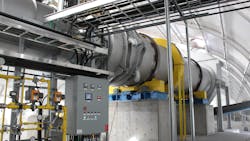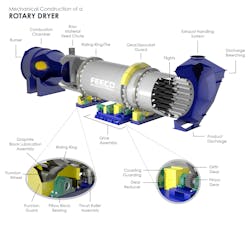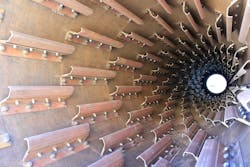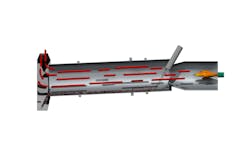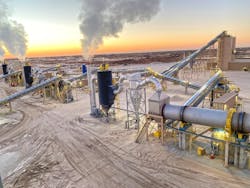Rotary dryers are a cornerstone of modern industrial processing, offering efficient, high-capacity drying for a wide range of materials. From traditional techniques to novel processes, rotary dryers are a diverse and reliable option for any facility looking to dry bulk solids.
The following covers the many benefits these industrial drying systems can offer as well as applications and limitations. The article also explains how these dryers work and discusses considerations in design.
Why choose a rotary dryer?
While a number of industrial dryer types are available, rotary dryers have remained a preferred choice for decades thanks to several key advantages:
Customization. Rotary dryers are extremely customizable, allowing producers to tailor a system to their precise material and process goals.
Reliability and longevity. Thanks to a robust build and simple mechanical operation, rotary dryers are recognized for their reliability and longevity. When properly maintained, a rotary dryer can operate for decades without issue.
Tolerance to feedstock variation. One key advantage particularly suited to many bulk solids processing operations is the rotary dryer’s tolerance to variation in feedstock and processing conditions. Unlike with some other dryer types, slight changes in particle size distribution, moisture content, and even throughput do not cause process upsets.
Added polishing of granules. Producers looking to dry a granular product also favor the rotary dryer for the “polishing” it can offer. The dryer’s rolling action helps to break off particle edges and further round granules, creating a premium product.
High throughput. Rotary dryers are also favored for their high-capacity processing, which ranges from 1 tph to over 200 tph. This makes them an ideal fit for working with bulk solids.
Rotary dryer operation
Rotary dryers consist of a large rotating cylinder (called the “drum”) set horizontally but at a slight angle. Material passes through the drum and is heated by a heating medium according to a predetermined temperature profile and retention (or residence) time to achieve a target moisture content.
A burner is mounted at one end of the drum, and exhaust gas handling equipment is mounted at the other end. Flexible seals connect the rotating drum to stationary inlet and outlet breechings.
Riding rings, or tires, support the drum and facilitate smooth rotation of the unit on trunnion roller assemblies. A drive assembly, most commonly a gear and pinion type, provides the power to rotate the drum.
Material is fed into the drum at one end and discharged at the other end, with gravity and the rotation of the drum shell helping to convey material along the slight downward slope through the unit.
Direct versus indirect drying
Drying can occur either directly, through material contact with the airflow, or indirectly, through material contact with the externally heated drum shell. For direct drying, a combustion chamber is recommended to prevent direct contact between the material and the burner flame. Direct drying is by far the most common, as it is significantly more efficient, but indirect drying offers an effective approach in niche applications.
Direct rotary dryers
Direct rotary dryers are used in a variety of industries working with bulk solids, processing everything from minerals and ores to chemical compounds and fertilizer products. In the direct configuration, hot air and combustion gasses are passed through the rotating drum, in direct contact with the material being processed, heating the material via convection.
Flights (also called material lifters) pick up the material and carry it up the drum wall as it rotates, then drop it through the air stream in a cascading effect, creating a curtain of material in the drum’s cross section that maximizes heat transfer.
The material and products of combustion may be fed into the same end of the unit (parallel or co-current flow) or into opposing ends (counter-current flow). The choice between co-current or counter-current flow depends on the characteristics of the material to be dried.
Co-current dryers are often chosen for materials that carry the bulk of their moisture as surface moisture, as this configuration puts the hottest air in contact with the material at its wettest point. The co-current configuration is also ideal for controlling material temperature, minimizing the potential for overheating the material, diminishing the potential for discoloring the material, and reducing the generation of fines (attrition).
In contrast, a counter-current dryer puts the material in contact with the hottest air at its driest point. This provides increased thermal efficiency for materials that must be heated to higher temperatures. The counter-current configuration is also beneficial when drying materials that have internal moisture and therefore require higher heat and an extended drying cycle to draw out the moisture.
Indirect rotary dryers
With the indirect configuration, the rotating drum is enclosed in a furnace or heat shroud, which is externally heated to prevent contact between the material and any process gasses, and the material is heated via conduction. While flights on the drum interior are ineffective in this configuration, bed disturbers are typically employed to ensure that the material bed is in constant rotation.
Indirect rotary dryers are used in settings where the material must not come into contact with process gasses or when the particle size distribution is very small, such that direct drying would risk the material becoming entrained in the airflow. As such, indirect dryers are typically employed in processing specialty products such as catalysts and adsorbents.
Rotary dryer applications and limitations
Few applications exist that are not a fit for rotary dryers. Their extreme versatility has them in use in nearly every industry. They are widely used to process:
- Aggregates, minerals, and ores
- Fertilizers and soil amendments
- Limestone and gypsum
- Organic and inorganic chemicals
- Paper pulp and sludge
- Potash
- Recycled manure solids (RMS) bedding
- Roofing granules
- Salts and sugars
- Sand
While rotary dryers are extremely universal in application, there are a few cases in which another dryer type, such as a fluid bed, may provide a better option.
Since rotary dryers pick up and drop the material during processing, some particle degradation can occur if the material is fragile. When fragility is a concern, a fluid bed dryer may be more suitable.
Some sludge-like materials can also be challenging for rotary dryers, though several options are available for managing a non-flowable material in the dryer, including the incorporation of a back-mix circuit.
Design considerations
While standardized designs are available on the market, rotary dryers offer the greatest efficiency, performance and reliability when designed according to the characteristics of the material to be dried, facility considerations and process goals. The following points are essential aspects of rotary dryer design.
Material
Rotary dryer manufacturers must consider a number of material characteristics when designing a rotary dryer. Characteristics such as particle size distribution, bulk density, raw material moisture content, specific heat, heat transfer properties, fragility, chemical composition and additional physical qualities, all influence how a material will respond to the drying process. A rotary dryer must be designed around these characteristics to optimize dryer performance and longevity.
For this reason, many producers can benefit from testing their material in a facility such as the FEECO Innovation Center. In this setting, a pilot-scale dryer is used for testing trials to gather critical process data and aid in the design of a commercial-scale unit.
It is important to recognize that material use can have ramifications on dryer design as well, particularly on whether the dryer must be direct or indirect depending on whether or not the material can be exposed to combustion gasses.
Facility
Operating facility factors can also influence dryer performance and must be considered during the design process. This includes elevation, whether the dryer will be operating indoors or outdoors, and climate, particularly humidity and ambient air temperature.
Exhaust gas handling
To meet regulatory emissions requirements, direct rotary dryers must be equipped with exhaust gas handling equipment. While indirect dryers must also meet local, state and federal regulations, their exhaust gas management requirements are minimal since the material does not come into contact with the products of combustion. For this reason, indirect dryers also hold greater potential for capturing and reusing waste heat in other applications in the plant.
The level of exhaust gas handling required in a given setting can vary significantly, depending on the specific emissions produced by the system and where the facility is located.
The most common configuration consists of an induced draft (ID) fan paired with a baghouse. This combination is ideal in settings where excessive carryover is not an issue and there is no need to treat the exhaust gas for chemical pollutants such as VOCs or fluorine. Other options include cyclones and scrubbers.
Automation and controls
Automation and control systems are powerful tools in optimizing dryer efficiency, minimizing maintenance requirements and avoiding process upsets. Not long ago, these systems were considered a luxury, but as technology has advanced, they have quickly become a necessity in efforts to improve efficiency and maintenance planning.
Systems range in complexity, from those that simply assist in startup and shutdown, to more advanced systems that can allow control from a remote location, alert operators when key parameters fall out of spec, and even provide trends and reporting around performance and operating data. This type of information is extremely powerful in predictive maintenance planning, as well as in optimizing overall efficiency.
Conclusion
Due to their versatility and benefits such as high throughput and long-term reliability, rotary dryers have become the preferred option for drying a range of bulk solids, from ores to chemicals and everything in between.
For optimal performance and longevity, rotary dryers should be designed around the unique characteristics of the material to be processed, as well as the process goals. This makes testing a significant advantage in developing a commercial-scale unit.
Facility considerations also influence the design process, while local, state, and federal regulatory requirements, along with the dryer’s unique emissions, dictate exhaust gas handling needs. Automation and control systems can help to maximize performance and longevity.
For these reasons, it is important to work with an expert supplier for the design and fabrication of a commercial-scale system.
Shane Le Capitaine is process sales engineer at FEECO International.
FEECO International
